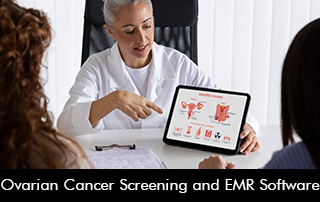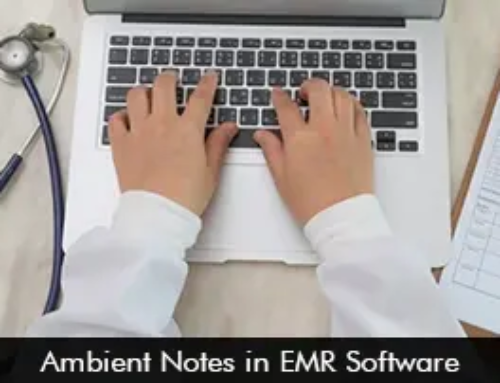Ovarian cancer remains one of the most challenging gynecological malignancies to detect and treat early. Integrating Electronic Medical Record (EMR) software into healthcare systems offers new opportunities to improve ovarian cancer screening and early detection. This blog explores the intersection of ovarian cancer screening and EMR software, highlighting this technological synergy’s potential benefits and challenges.
The Importance of Early Detection in Ovarian Cancer
Ovarian cancer is often called the “silent killer” due to its subtle symptoms in the early stages. When detected early, the five-year survival rate for ovarian cancer can be as high as 93%. However, most cases are diagnosed at advanced stages, significantly reducing survival rates. This underscores the critical need for effective screening methods and early detection strategies.
EMR Software: A Game-Changer in Healthcare
What is EMR Software?
EMR software is a digital version of a patient’s paper chart, containing comprehensive medical and treatment histories. It allows healthcare providers to track data over time, identify patients due for preventive screenings, and monitor parameters such as blood pressure readings or vaccinations.
Benefits of EMR Software in Healthcare
EMR software offers numerous advantages:
- Improved Patient Care: Provides quick access to patient records for more coordinated, efficient care.
- Enhanced Patient Participation: Allows patients to access their health information, fostering engagement in their care.
- Increased Practice Efficiencies and Cost Savings: Reduces the need for paperwork, and streamlines coding and billing.
- Improved Diagnostics and Patient Outcomes: Helps providers quickly identify and treat health issues.
EMR Software in Ovarian Cancer Screening
Risk Assessment and Identification
EMR software can play a crucial role in identifying women at high risk for ovarian cancer. By analyzing family history, genetic information, and other risk factors stored in the EMR, the software can flag patients who may benefit from more intensive screening or genetic counseling.
Tracking Symptoms and Test Results
Ovarian cancer often presents with vague symptoms that can be easily overlooked. EMR software can help track these symptoms over time, potentially identifying patterns that warrant further investigation. Additionally, it can store and analyze results from various screening tests, making it easier for healthcare providers to monitor changes and identify trends.
Implementing Clinical Decision Support
Advanced EMR software can incorporate clinical decision support tools that alert healthcare providers when a patient meets certain criteria for ovarian cancer screening. This feature can help ensure that at-risk patients receive timely and appropriate screening, potentially leading to earlier detection.
Challenges and Considerations
Data Privacy and Security
As with any digital health technology, ensuring the privacy and security of patient data in EMR software is paramount. Healthcare organizations must implement robust security measures to protect sensitive information related to ovarian cancer screening and genetic testing.
EMR Software Interoperability Issues
For EMR software to be truly effective in ovarian cancer screening, it needs to be able to communicate seamlessly with other healthcare systems. Interoperability challenges can hinder the exchange of crucial information between different providers and institutions.
User Training and Adoption
Effective use of EMR software for ovarian cancer screening requires proper training of healthcare providers. Ensuring that all staff members are proficient in using the software’s features related to cancer screening is essential for maximizing its potential benefits.
Future Directions
EMR Software and Integration of Artificial Intelligence
The future of EMR in ovarian cancer screening looks promising with the potential integration of artificial intelligence (AI). AI algorithms could analyze vast amounts of patient data to identify subtle patterns and risk factors that human observers might miss, potentially improving the accuracy of ovarian cancer risk assessment and early detection.
Personalized Screening Protocols
As EMR software becomes more sophisticated, it could enable the development of personalized screening protocols based on individual patient risk profiles. This tailored approach could optimize screening resources while maximizing the chances of early detection for high-risk individuals.
Enhanced Patient Engagement
Future iterations of EMR software could include more robust patient portals, allowing women to actively participate in their ovarian cancer screening process. These portals could provide educational resources, reminders for screening appointments, and tools for reporting symptoms or concerns directly to healthcare providers.
Conclusion
EMR software has the potential to revolutionize ovarian cancer screening by improving risk assessment, facilitating early detection, and enhancing patient care coordination. As this technology continues to evolve, it offers hope for better outcomes in the fight against ovarian cancer. However, realizing this potential will require ongoing research, development, and collaboration between healthcare providers, technology experts, and patients.
The integration of EMR into ovarian cancer screening protocols represents a significant step forward in women’s health. By leveraging the power of digital health technology, we can work towards a future where ovarian cancer is detected earlier, treated more effectively, and ultimately, where more lives are saved. As we continue to refine and expand the capabilities of EMR software, the outlook for ovarian cancer screening and management grows increasingly promising.








